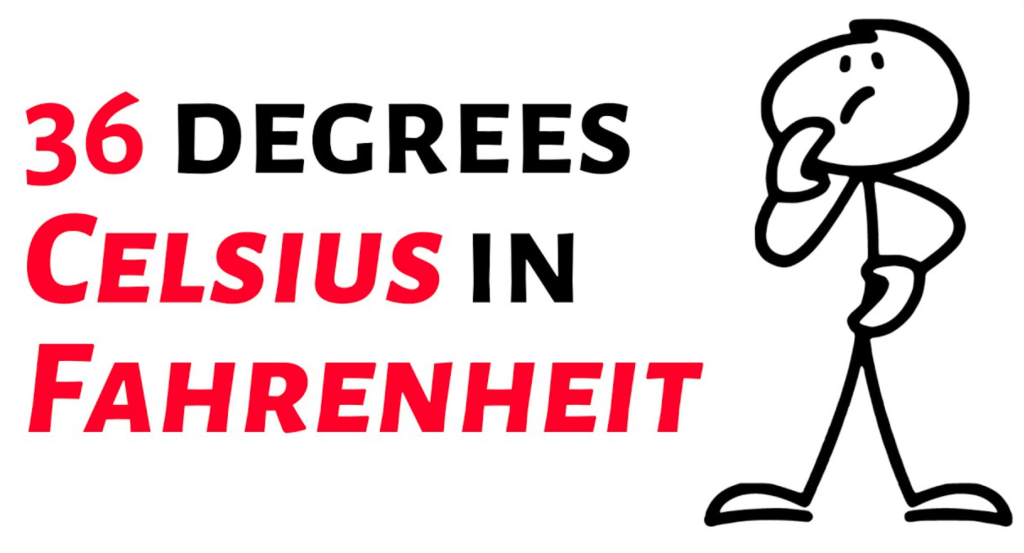What is 36 Celsius in Fahrenheit? A Comprehensive Guide
In our globalized world, understanding different temperature scales is more crucial than ever. Whether you’re traveling, cooking, or just curious, knowing how to convert temperatures between the Celsius and Fahrenheit scales can be invaluable. These two scales, each with its unique history and significance, dominate temperature measurements worldwide. This article delves deep into the conversion of 36°C to Fahrenheit, offering insights, practical examples, and the science behind it.

Quick Answer
For those in a hurry or need of a quick reference, 36 degrees Celsius is precisely 96.8 degrees Fahrenheit. This conversion is based on the formula used to switch between the two scales. But how did we arrive at this number, and what’s the story behind these two temperature scales? Let’s explore further.
Understanding the Conversion
The Celsius and Fahrenheit scales have distinct origins, each rooted in different parts of the world. The Celsius scale, named after the Swedish astronomer Anders Celsius, is based on the freezing and boiling points of water, set at 0°C and 100°C respectively. On the other hand, the Fahrenheit scale, crafted by the Polish-German physicist Daniel Gabriel Fahrenheit, has its zero point set at the freezing temperature of a saltwater mixture, with water’s boiling point at 212°F.
The need to convert between these scales arises from their widespread use in different regions. For instance, while most of the world uses Celsius for weather forecasts, the United States predominantly uses Fahrenheit. This dichotomy can lead to confusion, especially when dealing with specific temperatures like 36°C. Is it warm, cold, or just right? Understanding its Fahrenheit equivalent, 96.8°F can provide clarity, especially for those more familiar with the Fahrenheit scale.
The formula for converting Celsius to Fahrenheit is straightforward:
(9/5) + 32 = °F**. Using this formula, the conversion of 36°C to Fahrenheit becomes clear:
(36°C × 9/5) + 32 = 96.8°F
But why does this formula work, and how did we come to adopt these two scales in different parts of the world? The answer lies in the rich history of scientific exploration and the evolution of temperature measurement.
Step-by-Step Conversion Method
For those who love a detailed breakdown, let’s dive into the conversion process:
1. Multiply the Celsius Temperature by 9/5: This fraction, 9/5, is the ratio of the difference between the boiling and freezing points of water on the Fahrenheit scale (212°F – 32°F = 180°F) to that on the Celsius scale (100°C – 0°C = 100°C). For 36°C, this calculation would be: 36°C × 9/5 = 64.8
2. Add 32: The number 32 is added to adjust for the difference in the zero points of the two scales. As mentioned earlier, water freezes at 0°C and 32°F. Adding 32 to our previous result gives: 64.8 + 32 = 96.8°F
Thus, 36°C is equivalent to 96.8°F.
Commonly Asked Questions
– Is 36°C considered a fever?
While 36°C (96.8°F) is close to the average human body temperature, it’s slightly below the often-cited average of 37°C (98.6°F). Therefore, 36°C is not considered a fever. It’s within the range of normal body temperatures.
– How does 36°C feel in different climates?
In dry regions, 36°C might feel warm but bearable. However, in areas with high humidity, this temperature can feel much hotter due to the moisture in the air preventing sweat from evaporating and cooling the body efficiently.
Quick reference for other common Celsius to Fahrenheit conversions:
Understanding a range of conversions can be handy. For instance, 37°C is 98.6°F, 38°C is 100.4°F, and 39°C is 102.2°F.
Natural Language Processing and Temperature
In today’s digital age, the way we search for and process information has transformed dramatically. Natural Language Processing (NLP), a branch of artificial intelligence, plays a pivotal role in this evolution. But how does NLP relate to temperature conversions?
1. Voice Assistants and Smart Devices: When you ask your voice assistant, “What’s 36°C in Fahrenheit?”, it’s NLP at work. These devices understand human language, process the request, and provide an accurate conversion without you having to do the math.
2. Contextual Understanding: Modern search engines, powered by NLP, can provide results based on the context. For instance, if you’re reading an article about baking and you search for “oven temperature 36°C to Fahrenheit”, the search engine understands the context and prioritizes baking-related results.
3. Enhancing User Experience: NLP-driven tools can offer more than just direct conversions. They can provide related information, like the ideal temperature for specific tasks or the significance of a particular temperature in medical contexts.
Additional Resources
For those keen on diving deeper into the world of temperature conversions and measurements, there are a plethora of resources available:
1. Interactive Temperature Conversion Tools: Online calculators allow you to input any Celsius temperature and get its Fahrenheit equivalent instantly.
2. Charts and Tables: Quick reference charts, available on many educational and scientific websites, offer a range of conversions at a glance.
3. In-depth Articles and Studies: For the academically inclined, there are numerous papers and articles detailing the history, science, and significance of temperature scales.
Conclusion
The journey from 36°C to its Fahrenheit equivalent is more than just a mathematical conversion. It’s a voyage through history, science, and the marvels of modern technology. As our world becomes increasingly interconnected, understanding these nuances allows us to communicate more effectively, make informed decisions, and appreciate the intricate tapestry of knowledge that binds us all together. Whether you’re a traveler, a chef, a student, or just a curious soul, the world of temperature is a fascinating realm waiting to be explored.




